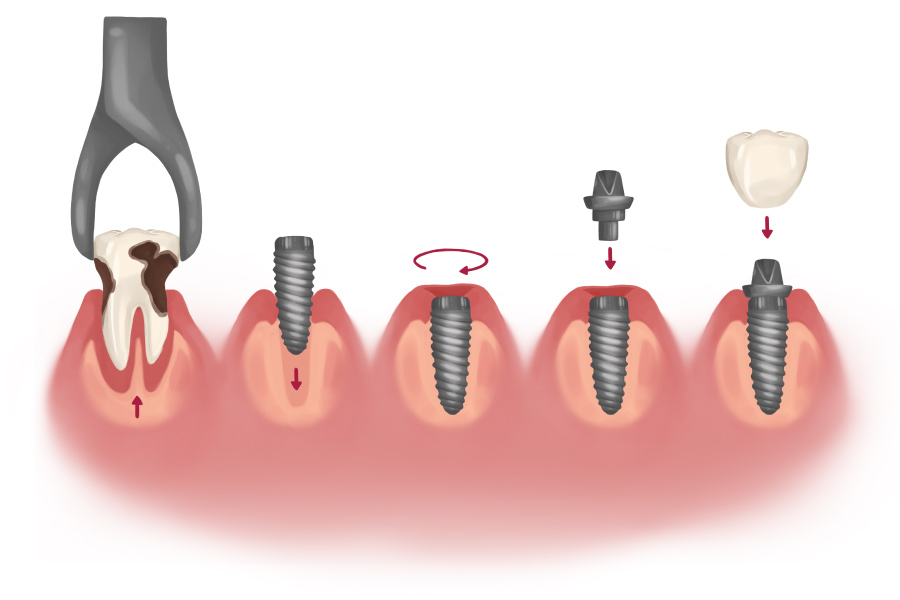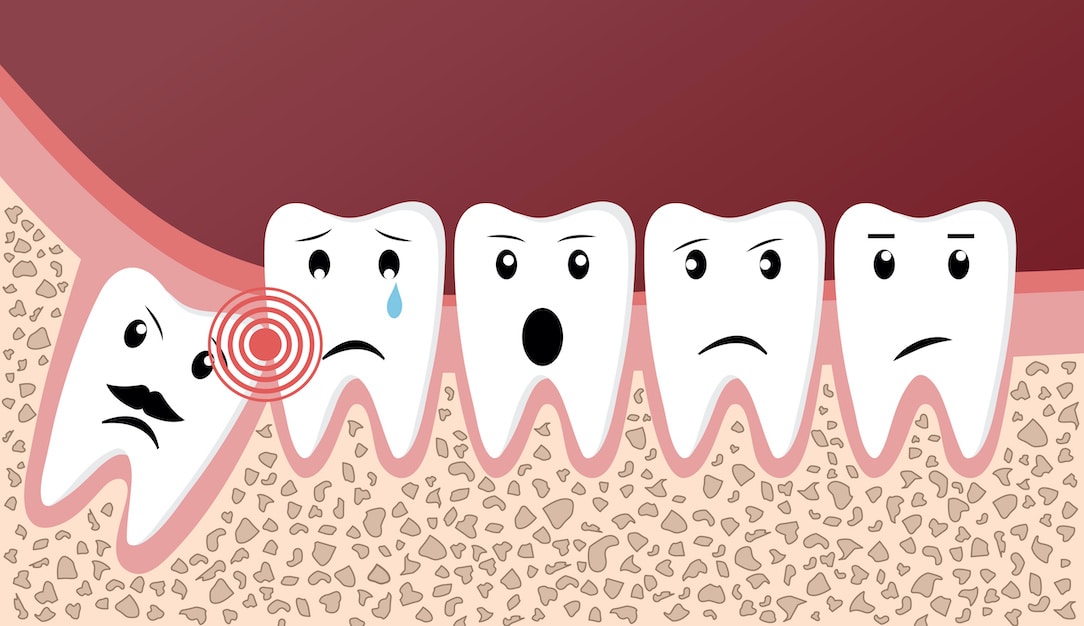Most people get their wisdom teeth removed because they don’t have enough room to come in and can grow in a way that leads to pain or dental issues. This is called an impacted wisdom tooth. The difference between a coronectomy and a traditional wisdom tooth removal is that the Coronectomy removes only the crown or visible parts of the tooth. It leaves the roots intact and in place.
The coronectomy came about because the roots of wisdom teeth sometimes grow too close or even on top of the inferior alveolar nerve, which connects to your tongue, lips, and lower jaw. Injury to this nerve from a faulty wisdom tooth removal may affect your feeling in these areas.
What are your wisdom teeth?
Located in the very back of your mouth, your wisdom teeth are your third set of molars. They typically come in when you’re in your late teen years and are your last set of adult teeth. For many people, one or more wisdom teeth don’t have enough room to grow properly and break (or erupt) through the gum. These wisdom teeth are referred to as being impacted. Often, your dentist will suggest removing impacted wisdom teeth — called an extraction — because they tend to be prone to decay and disease.

Coronectomy vs. Extraction
A standard wisdom tooth extraction will remove the entire tooth, and sometimes all four are removed at once. A coronectomy will remove the crown of the tooth and leave the tooth’s roots in your jaw, intact. It isn’t recommended if the wisdom tooth or root is infected.

Both procedures may be done by a dentist or oral surgeon. Your dentist will likely decide on one procedure over the other depending on factors such as your age and likelihood of nerve damage. A standard wisdom tooth extraction will remove the entire tooth, and sometimes all four are removed at once. A coronectomy will remove the crown of the tooth and leave the tooth’s roots in your jaw, intact. A coronectomy isn’t recommended if the wisdom tooth or root is infected.
Why have a Coronectomy?
Sometimes the wisdom teeth roots are close to and press on your lingual nerve (LN) or inferior alveolar nerve (IAN), the nerves that supply feeling to your tongue, lips, and chin. In situations like this, your dentist or oral surgeon might recommend a coronectomy as an option that could lower risk for potential nerve damage as compared to an extraction. Damage to your LN and IAN might result in;
✪ Pain or odd sensations in your lower lip, lower teeth, lower jaw, or chin
✱ Difficulties speaking or chewing
✪ Loss of taste
When to have a Coronectomy?
The coronectomy came about because the roots of wisdom teeth sometimes grow too close or even on top of the inferior alveolar nerve, which connects to your tongue, lips, and lower jaw. Injury to this nerve from a faulty wisdom tooth removal may affect your feeling in these areas.
You can avoid the risk of permanent numbness or tingling by leaving the tooth’s roots. But you shouldn’t have a coronectomy if there is any issue of decay or infection with your tooth or the roots. Leaving in decayed or infected roots will only lead to more complications.
What Should I Expect From a Coronectomy?
You will typically have a coronectomy before the wisdom tooth has fully emerged. Your dentist will first have to make a small cut into your gum and remove some of the bone around the tooth. This will let them remove only the crown of the wisdom tooth. Afterward, the gum will be sewn back together. The procedure usually takes about 40 minutes. You notice side effects like these for up to 14 days:
- Trouble opening your mouth
- Bleeding from the wound
- Infection at the wound site
- Bruised or injured nerves
- Swollen gums
It might help to switch your diet to soft or liquid foods while you heal. You may also need to wear bandages to protect the inside of your mouth. Be careful and gentle with your dental hygiene, and make sure to clean your mouth thoroughly.
Coronectomy: Specific Warnings:
Roots inadvertently removed at the time of attempted coronectomy: When the crown of the tooth is mobilised, the roots (if the crown is still attached to them) may become mobile as well. This ranges from 3 – 9%. If the roots are mobile, we are obliged to remove them and there is obviously the risk to the IAN (which this procedure was trying to avoid). This is more likely to happen if the roots are conical in shape.
Incomplete Crown Removal (link to annotated picture). Not being able to visualize the root surface is a common problem with disto-angular impactions and makes root finishing difficult. This may mean that all the enamel has not been removed. Retained enamel or spicules of enamel can cause irritation to the overlying gum or, as the enamel acts as foreign body, increases the chances of infection of the unhealed socket.
Coronectomy guidelines
Coronectomy can be beneficial but success requires both good patient selection and operator technique. There are some simple guidelines which clinicians need to be aware of to avoid failure. They are as follows:
- Teeth with associated infection, particularly infection involving the root portion, should be excluded from this technique
- Teeth that are mobile should be excluded as they act as a mobile foreign body and become a nidus for infection or migration
- If the pulp of the tooth is exposed, the technique of leaving the retained root fragment at least 3 mm inferior to the crest of the bone seems appropriate and appears to encourage bone formation over the retained root fragment over a period of time.
- Late migration of the root fragment may occur in some cases, but is unpredictable. However, in most cases the root fragments move into a safer position with regard to the nerve and then can be removed. Case reports have suggested that it can take up to ten years for the root fragments to erupt.
- The operative site should be primarily closed in a tension free manner.
Post Operative Management of Coronectomy
Swelling
In case there is swelling, it lasts for up to a week. The amount of swelling varies from patient to patient. In addition to this the application of an ice pack during the first 24 hours postoperatively may help. Do not apply the ice pack directly to your skin, but wrap the ice pack in a towel first.
Restricted mouth opening
This occurs sometimes and is a consequence of swelling; it often settles once the swelling disappears. During this time when your mouth opening is restricted you may have to modify your diet, eating soft foods. There are however no hard and fast rules about what you should eat. You must however keep your mouth as clean as possible to reduce the risk of infection using regular mouthwashes.
Bleeding
Although there may be a little bleeding at the time of the procedure this usually stops very quickly and is unlikely to be a problem if the wound is stitched. If by chance the area bleeds again when you get home this can usually be stopped by applying pressure over the area for at least 10 minutes with a rolled-up damp cotton or swab.
Minimising Infection
Infection can be minimised by adopting scrupulous oral hygiene during the recovery phase. This usually encompasses normal tooth brushing with additional mouthwashes as advised plus the avoidance of smoking.
Advantage of Coronectomy
Two nerves lie in close proximity to impacted wisdom teeth. The lingual nerve provides sensation in your tongue whilst the inferior alveolar nerve gives sensation to the lower lip and skin overlying the chin. These nerves may be bruised during tooth removal. A coronectomy technique ELIMINATES THE CHANCES OF NERVE DAMAGE and consequently the numbness to the lip and chin.
Royal Dental Clinics is known for its comprehensive, corrective and preventative procedures which are performed in a comfortable environment. Royal Dental Clinics not only excels at implants, but also modern cosmetic dentistry. It provides excellent cosmetic solutions, thereby providing a ‘smile makeover’.






